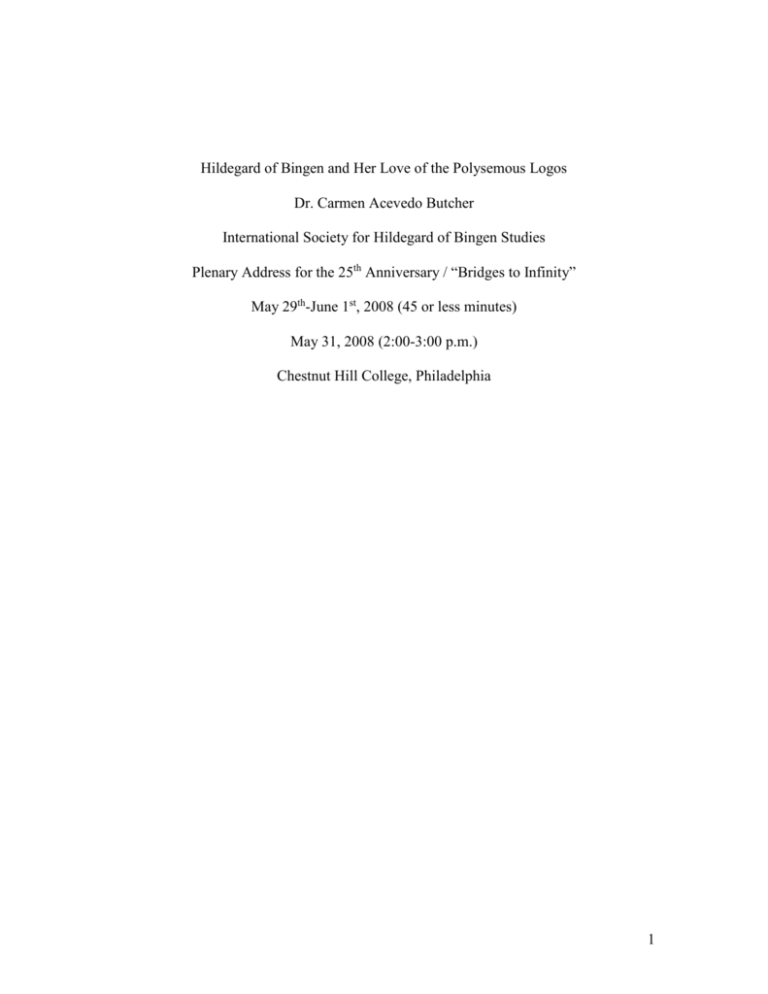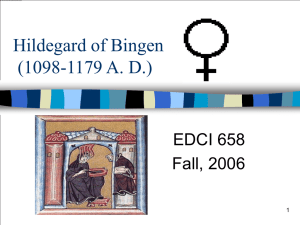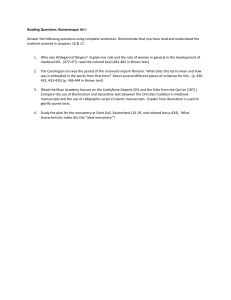Hildegard of Bingen and the Polysemous Logos
advertisement

Hildegard of Bingen and Her Love of the Polysemous Logos Dr. Carmen Acevedo Butcher International Society for Hildegard of Bingen Studies Plenary Address for the 25th Anniversary / “Bridges to Infinity” May 29th-June 1st, 2008 (45 or less minutes) May 31, 2008 (2:00-3:00 p.m.) Chestnut Hill College, Philadelphia 1 Thank you, Pozzi, for the invitation to participate in this engaging celebration of Hildegard, and, Bruce, thank you for the warm and wonderful community you had the foresight to found. Thanks also to Don for his help today in setting up the computer, and to Sister Terez and to Marie for their splendid help also. Hildegard encourages in Scivias, “Don’t let yourself forget that God’s grace rewards not only those who never slip, but also those who bend and fall. So sing!” Taking her advice to heart, I’d like to back up a few 100 years and cross an ocean to AngloSaxon England, where we find a song written by the seventh-century cowherd and later Benedictine monk, Cædmon, praising God in a way suggestive of the joy that makes Hildegard’s own Benedictine work come alive. Hildegard’s hard-won joy means much to me. And this song by Cædmon, the cowherd turned Benedictine monk, reminds me of the Benedictine tradition in which Hildegard established her unique place. To save time, here is a translation from my website for you to read as I sing—there are many good translations online. [Home/Classes/Handouts/Old English/Click and roll down.] Sing Cædmon’s Hymn. [This song and its tune may be heard at www.youtube.com, at http://www.youtube.com/watch?v=2HsxnJ8ccCs; or put in Aelfricofeynsham (no spaces) and click on “Hildegard of Bingen: A Spiritual Reader.” The song is of course by Cædmon, and the melody is copyrighted by Carmen Butcher.] My idea of prime television viewing would be the old Steve Allen show, Meeting of the Minds, featuring actors playing Cædmon, Hildegard, Carl Jung, Voltaire, Pablo Neruda, and Rumi. This plenary lecture will—in the “fullness” of time—give us plenty of space this afternoon to explore Hildegard’s plenitudinous works, looking especially at her 2 polysemous diction as a “bridge to infinity.” Specifically, we will see how this Benedictine nun deliberately chooses her Latin words to express her worldview and to liberate her listeners / readers from the confines of this physical world, for new life in the spiritual one. In this way, she is a poet in everything she wrote. Examples will be given of her “deliberate” use of diction, especially in words such as oculus, ordo, virtutum, and viriditas, and we will follow these through her diverse and cohesive corpus, to see how they articulate her Weltanschauung. As we start this journey together, let us consider something that Jacob Bronowski observes in Science and Human Values (1958), quoted by Pozzi Escot in The Poetics of Simple Mathematics in Music: Bronowski says that [quote] “discoveries of science, [and] the works of art are [both] explorations [and] explosions, of a hidden likeness.” [end quote] Today as we look at Hildegard’s sensitivities to words, their etymologies and meanings, we are looking for “explorations [and] explosions, of a hidden likeness.” In other words, I would like in this lecture to share my lectio divina approach to Hildegard’s diction. Not unlike a Benedictine who reads a text, steeping his or her soul in several of Hildegard’s key words and concepts, I find etymology a tool for exploration into the spiritual. My students soon discover that, I am, in fact, addicted to etymologies. So let’s start with two words essential to this plenary lecture, deliberate and polysemous. As you know, deliberate ultimately comes from the Latin líbra for “weigh, balance, scales”—in other words, “to consider.” And polysemous originates in the Greek word meaning “many” from poly- and “sign” from sêma, and if we compare semaphore, we see the same sêm(a) for “sign,” with the phore originating in the Greek word for “to carry.” 3 Now let’s consider a passage from chapter 2 of Walden, where American author Henry David Thoreau declares: I went to the woods because I wished to live deliberately, to front only the essential facts of life, and see if I could not learn what it had to teach, and not, when I came to die, discover that I had not lived. I did not wish to live what was not life, living is so dear; nor did I wish to practice resignation, unless it was quite necessary. I wanted to live deep and suck out all the marrow of life, to live so sturdily and Spartan-like as to put to rout all that was not life. Hildegard lived deliberately and used language deliberately, with the joy of a poet, and that is why her polysemous diction is a “bridge to infinity.” At some point, surely we have all asked and perhaps still do ask—How can I get a handle on Hildegard? Trying to answer that question is as challenging to me as trying to move thirteen large and bursting suitcases through a packed airport en route to a foreign land, with two small children in tow. My husband, Sean, and I chose this experience when we wanted to get better acquainted with our Korean son’s birth country. We adopted John Min-Woo when he was a baby, and in 2004-2005, we went to Seoul as a family to learn about our son’s birth culture. I taught as a Fulbright Senior Lecturer at Sogang University. This was a true learning experience for a middle-aged couple and for two children three and eight. My family’s long trip into the otherness of Korea began one hot, sticky summer afternoon when my parents left us at the Atlanta airport, where Sean and I stood rooted to the spot, staring at those bags. They’d grown since we’d left home, hadn’t they? Who hasn’t had that feeling while studying Hildegard? But my husband found a cart, and on it 4 we stacked, restacked, and stacked again bags that slipped, slid, and generally collided. Finally a porter helped us. With two hands, she heaved each suitcase up on the outsized four-wheel trolley, shoving them one by one into a tilting pile more fluid than I expected heavy-duty-polyester-fabric-with-push-button-locking-handles-and-inline-skate-wheels could be. One of us was forever massaging this mound back into place as the porter rolled us through the crowded airport and directly to the right check-in counter. Dealing with our heavy suitcases en route to a new and unfamiliar country is not unlike grappling with Hildegard’s profound writings on a journey into the mystery of God. As we have seen together in so many brilliant papers and performances, Hildegard’s work resists easy organization and facile lifting. Her descriptions of and engagement with the “divine living Light” require idea-bursting, ever-shifting paradoxes and an awareness that embracing life’s heft (whether spiritual or Samsonite) is possible only in community. Hildegard’s Mt.-Everest-sized lifework certainly expands under close examination. Take one pebble of an example—the Latin in her ground-breaking allegorical musical, Ordo virtutum (The Play of the Virtues). This work uses words chosen skillfully for their many different levels of meaning. These polysemous words sink into the heart and then grow, like good poetry, or, to continue with a Hildegardian garden metaphor, like fertile seeds. Her pioneering musical opens with a chorus of Old Testament Patriarchs and Prophets singing to the personified New Testament virtues (such as Humility and Charity): They sing, [quote] “We’re the roots, and . . . you’re the apple [or more literally, the fruit] of the living eye.” This line is richer when we see the deliberate skill in Hildegard’s having picked the Latin oculus for “eye” in “the living eye” above. In addition to its anatomical 5 meaning of “eye,” oculus has the botanical definition of a “leaf, shoot, or flower bud.” With one carefully selected word, Hildegard has set up a complex image. The patriarchs and prophets who prefigured and predicted Christ were the “roots,” she says, of God’s divine tree, on which sprouted the most delicate “bud,” who is God’s Son, and from Him grew the “fruit” of the virtues: Humility, Charity, Patience, and their sisters. This metaphor is one of Hildegard’s favorites, and in her songs she praises the Virgin Mary as the “twig” or “branch” on which the “bud,” baby Jesus, flowered. By her intelligent selection of this one word, oculus, Hildegard has shown the center of her work—that to see God is to grow. In her lexicon, seeing and growing are synonymous. This example also suggests the complexity of Hildegard’s work. Each pilgrimage I make through Hildegard’s works convinces me that “getting a handle” on her is not the objective. Luggage is one thing, but who can lift a mountain? Instead, I like to follow a gentle path up through her art, paying much attention to her diction, for, as we all know, she is a poet and an artist whose creativity never marched down an a-b-c, 1-2-3 path but was always engaged on more than one front and in more than one genre, also loving to mix genres. One of the greatest joys of this conference has been hearing Hildegard’s and so much transporting music live. Like many students of Hildegard, I knew her music before I knew her prose or illuminations. This is apt, because harmony seems to be Hildegard’s own starting point. Her earliest spiritual experiences were spent chanting the Benedictine Opus Dei, putting plainsong at the center of her spiritual walk. Singing was her way to God. 6 Let’s look again at Hildegard’s sung liturgical drama. The Latin title and ancient morality-play message of this allegorical musical might, on first contact, numb the minds of college or university juniors or seniors, so, with the hopes of engaging my students in their world, for my purposes, I designed a webquest for my upper-level British literature classes, particularly for students in my interdisciplinary studies Medieval Women Mystics course. This webquest is a sturdy bridge between my typewriter age and my students’ Wi-Fi generation. Here is the webquest online. And, if you’d like, after the talk I have a handout for you about the webquest and where to find it online. [Show them the webquest at Home/Quests/#12: Avoid look/translation.] Harry’s talk this morning was so brilliant and thought-provoking that I want to insert here that I think one of the most educative things I’ve ever done is explore YouTube and learn, with my husband’s help, how to make pedagogical videos to upload onto YouTube. I’ve made four of these and want to involve students in the process, now that I’ve learned more how to do it. These can be found at www.youtube.com, under Aelfricofeynsham (no spaces). [Show them this, too.] Back to the webquest now. *** Using the webquest allows me to cast my pedagogical net wide. It also lets my students and me explore the Oxford English Dictionary both online and in print versions. When I announce to students that we’ll be participating in a webquest in order to understand Hildegard better, someone invariably asks, “What’s that?” Together we go to the WebQuest.org site and read: “A WebQuest is an inquiry-oriented lesson format in which most or all the information that learners work with comes from the web.” 7 My students and I discuss that, instead of the long-accepted title, The Play of the Virtues, a more suitable modern-English moniker for Hildegard’s Ordo virtutum might be the more literal translation The Order of the Virtues. Let’s look carefully at those two Latin words, ordo and virtutum. Ordo obviously means “a series, line, or row,” literally, that “order” (or “obedience”) that the Virtues (such as Humility, Charity, and Hope) bring to the world. Without them, Hildegard knew, only chaos results. She also chooses ordo for its useful military connotations of “rank and file,” or a “line” of soldiers. It suggests the spiritual warfare the play depicts, and especially the seventeen Virtues as a mystical fighting unit. Additionally, ordo connotes hierarchy in many Hildegardian ways: It is the social “class” accepted by Hildegard as divinely determined; it is the religious “rule” under which a monastic community lives, such as “the Order of St. Benedict”; and it is also “an order given by a superior,” each suggesting the necessary obedience and respect for authority that is the leitmotif of Hildegard’s redemption drama. Next, we look closely at virtutum. Virtue of course comes from the Latin vir for “man,” as also seen in virile, and this female abbess of women, Hildegard, often plays off of this notion of “manly” versus “womanly.” In her Book of Divine Works, finished in 1173 after a decade, she wrote in her mid-seventies: [quote] “Now we live in a time of womanly infirmity, because everyone does only as they please. No one does what is right, and the Church is abandoned, like a widow who has lost the companionship of her husband, who once protected her and helped her.” [end quote] Five or six years later, Hildegard wrote to the Prelates at Mainz, [quote] “This is a weak, womanly age, and the Church is neither as truthful nor as kind as it should be. However, God is at work. Like a female warrior, God fights to vanquish every type of unfairness on earth.” [end quote] As 8 the Cambridge musicologist, Christopher Page, said in a 2006 interview, “Hildegard is a remarkable woman in an age of remarkable men,” and she knows full well that when she calls the heavily male-led age “womanly” that that is a scathing and ironic indictment. As Catherine E. Karkov points out in her “Broken Bodies and Singing Tongues: Gender and Voice in the Cambridge, Corpus Christi College 23 Psychomachia” in AngloSaxon England 30, Latin grammatical gender dictated that both vices and virtues be feminine (123), since all of the Latin nouns for the abstractions are feminine. In this tenth- or eleventh-century manuscript, Cambridge, Corpus Christi College 23 Psychomachia (CCCC 23), the vices and virtues are both depicted as female (123-124). But the underlying notion of the vices reflects their “monstrous” history, and the depiction of the virtues reflects their “masculine” heritage and power. Hildegard takes Jerome’s model of spirituality, and in her play, Ordo virtutum, she presents her nuns playing the allegorical roles of the virtues as [to quote Karkov] “the traditional saintly women who overcome their gender to become spiritually male” [end quote] (125). In her Book of Divine Works, Hildegard sees the virtues as “pregnant” with real spiritual growth, saying that one of the “signs of the end times” is dessication because virtue “dries up.” She comments [quote]: There will be no justice then, because the greenness of virtue will have withered. The freshness of the earth will also dry up, because the atmosphere will no longer be pure, as it was originally. Summers will become cold, and winters will be hot. The Son said to His Father, “In the beginning, Creation was green. It flowered. That was a virile time. [end quote] 9 And in Scivias she writes, [quote] “I’ll look to and turn to the God of peace, because then I’ll have spiritual joy as the virtues begin to show themselves in me, strengthening me with their vibrant greenness.” [end quote] In her mind, clearly virtues and the vigor of viriditas are synonymous. In other words, she brings us back full circle gender-wise. She is gender wise, in fact, equating virtue (which has a masculine Latin gender and overtones of manly/masculine strength) with viriditas (which has a feminine grammatical gender and “feminine” definitions of greenness and interior growth). I think of Elizabeth’s paper yesterday, with its splendid discussion of cultural exectations and gender valences. Of course, Hildegard was fond of paradoxical lexical shifts. For example, in her poetry she enjoyed and often made much of the easy paronomasia found in the words virgo for “a maiden, virgin, girl,” and virga, “a green twig, a slip; a rod; a wand; a broom.” In other words, her virgins were the most “fruitful” of all God’s creatures spiritually, as the virgin Mary was the mother of the Word, the Creator of all. The virgin Mary is the “twig” giving birth to the “Flower” who died on the cross, that ur-tree. We are going to read two of Hildegard’s songs’ lyrics together because they illustrate her fondness for paronomasia as well as this virtue-engendering notion of viriditas. [Read the two poems from your book—pages 34 & 35.] Hildegard’s use of metaphors here suggests that she saw no separation between symbol and fact. Metaphors were reality to her. Her point in these songs is that the divinely-made sun that gives earth life is also, in a mystical way, the life-giving Son of God who as the Word made creation’s every twig, including Mary, and yet was also 10 Mary’s “Bloom.” In other words, God’s Son (capital S-o-n) is a sun (s-u-n) is a Son (capital S-o-n) is a sun (s-u-n), to rephrase Gertrude Stein. In these songs to Mary, the sun (s-u-n) (also God’s Spirit) shines on the Virgin Mary, the “greenest twig.” She is a twig, not even a branch, but she is green with God’s pregnant vitality, and her comparative insignificance (as a woman, and unmarried) prepares her for the greatness of God’s Spirit to grow within her and produce the miraculous “flowering” of God’s divinehuman Son. Her weakness is her strength, a recurring theme in Hildegard. With all of Hildegard’s potentially incapacitating medical issues, she must have found a way to tap into the well of holy joy—today we would say, “She learned to cope, heal, find closure.” She would have said she found “joy” in an awareness of God’s secrets. But how can we be “conscious” of divine secrets? Hildegard tackles this age-old question head-on: Can we see God? Her answer is synonymous with Psalm 19, that we can see God’s vigor in the world around us: [quote] The heavens are telling the glory of God; and the firmament proclaims his handiwork. Day to day pours forth speech, and night to night declares knowledge. There is no speech, nor are there words; their voice is not heard; yet their voice goes out through all the earth, and their words to the end of the world. Again, Hildegard called this vigor viriditas, the “green” energy of agape love pulsing through the entire universe. Over and over in her writings, she chooses viriditas 11 to express God’s vitality and the ways His goodness and love charge the whole world with life, beauty, and renewal—literally, with “greenness.” Her uniquely creative use of this Latin word makes it something of a neologism in her work. In Hildegard’s mind, viriditas was first found physically in the green of the garden of Eden, but it is also the green of whatever twig you or I happen to be looking at in this present moment, whoever we are, wherever we may be. She knew that the natural opposite of this “greening” energy was spiritual desiccation (including what we often call “depression” and what we know but rarely refer to as acedia, as Kathleen Norris discusses in her upcoming, soon-to-be-released book Acedia & Me). Like God’s mercy, God’s revitalizing viriditas has no limits. Wherever Hildegard looked, she saw that this “green” force animates every creature and plant on this planet with verdant divine love. With our Facebook generation, it is easy to forget the miracles of nature. When I was a Senior Fulbright Lecturer in Seoul, winter seemed unending. We had no car, so I walked everywhere hunched-down and pulled-in for five long months of razor-sharp winds slicing icily through leafless trees in gray skies, until one day when I happened to look up, I was as shocked as I was thrilled to see that the dark, dust-covered bushes in front of Sogang University’s Xavier Hall had begun unfurling the tiniest curls of tender green in the suddenly warm sunshine. That was good news! After an indefinite-seeming frozen time, nothing can be more exciting than spring. Hildegard lived through countless dramatic German winters and knew this knowledge, too, in her very bones. I watched viriditas resurrect the Sogang University campus that spring. It began glowing with the purest white cherry tree blossoms against bright green leaves. After the bitterest winter, they felt like a gift. This was also Hildegard’s perspective. She saw 12 flowers—literally the most beautiful reproductive form of natural plant growth—as the height of viriditas. To her, they symbolized in a mysterious way our obedience to God, and she saw God’s crucified, incarnate Son as the best example of the Flower. In Scivias, Hildegard takes this notion further, using the image of a rejected flower to describe the fall of humanity. Failing to accept God’s brilliant, sweet bloom, the first humans plunged humanity into a sterile darkness. A splendid example of the use of viriditas and of the nature imagery central to Hildegard’s work is found in a letter she wrote responding to a polite-but-critical letter she had received from Mistress Tengswich, the superior of a foundation of canonesses in Andernach and the sister of Richard of Springiersbach. Tengswich and her brother were reformers; they advocated apostolic poverty, and Tengswich vehemently disagreed with some of Hildegard’s approaches to monastic life. Her principal concern was that Hildegard permitted the virgins in her community to let their hair down for liturgical celebrations. Tengswich may have been referring to a costumed performance of The Play of the Virtues. Hildegard’s response to Tengswich at mid-century shows that in the hierarchy of Hildegard’s mind, virgins were the apex of creation: [quote] They’re the green of an eternal Springtime. They’re the closest thing we have to Eden. The beauty of woman sparkled in the Ur-root, when she was given her womb, that inner cell which gives birth to every person. Why is woman so radiant? God’s hand made her. He gave her an awesome beauty. Woman, what a marvelous creature you are! By grounding yourself in the Sun, you conquer the world. [end quote] 13 Hildegard viewed herself and her nuns as co-participants in God’s rejuvenating Energy. The poet Dylan Thomas plants the word green throughout his work to suggest something equally mysterious: [quote] “The force that through the green fuse drives the flower / Drives my green age,” he says, and in “Fern Hill,” he chooses green seven poignant times to describe the root vitality of his childhood, when he was “happy as the grass was green.” We must also remember what Hildegard wrote to the prelates at Mainz, about original sin, for she uses a flower (that crown of the greenness of viriditas) to symbolize obedience, writing this: [quote] In fact, before Adam refused God’s fragrant flower of obedience, his voice was the best on earth, because he was made by God’s green thumb, who is the Holy Spirit. And if Adam had never lost the harmony God first gave him, the mortal fragilities that we all possess today could never have survived hearing the booming resonance of that original voice. In other words, as seen in her letter sent sometime-before-1155 to Abbot Kuno of St. Disibod, Hildegard equates humility with the power of viriditas. Garden metaphors again abound in the etymology of these words, humility and viriditas. She writes to Abbot Kuno about the nature of humility—that it is essentially a willingness to be taught and to change: [quote] [Page 107 in your book:] An immature man always stubbornly refuses to change. He’d rather be a busybody, digging in the private business of others and then broadcasting their secret bad habits. This man must hear the Lord: “Why don’t you respect your fellow human beings?” [End quote.] 14 Next, she answers Abbot Kuno’s question, sending him her poems on Disibod, his monastery’s patron saint. She says that she is sending him the “songs” she saw about Disibod in one of her visions. And here is an excerpt from one of these “songs,” replete with the garden imagery that naturally rises up out of the words humility (humilitas) and viriditas: [quote] What a wonderful wonder! Someone-many-overlooked has triumphed! His honest heart took him far, up the mountain, to the living, mystical Voice. Disibod, you’ll rise on Doomsday, too, as you rose on earth, empowered by the Flower growing on every bough, in every land, all over this globe. O viriditas digiti Dei You’re the green thumb God used to plant a garden that shines on the Hill like a column. You’re wonderful, because you worked hard in God’s endlessly blooming yard! [end quote] Hildegard closes this letter as she opened it, with a plea to Abbot Kuno for humility: [quote] 15 Father, I’ve answered the questions you’ve asked me. Now I ask you: Humble yourself before God. Become a poor heartbroken creature in His sight, like I am. Then, when you die on earth, your happiness will last throughout eternity, and you’ll be rewarded with the salvation given to those who are honest. It may help to remember that Golda Meir once said, “Don’t be so humble; you’re not that great.” You know that humble comes from the same root as humus, for “earth.” We can compare the words, exhume and human. Or think of our phrase, “He’s the salt of the earth.” Or, “She’s down-to-earth.” To be humble is, in a sense, to be grounded, to be real, which is exactly what it means to be a meaningful part of a vibrant, loving community. Let’s look a little further at the etymology of humility, which reminds me of my favorite British colloquial phrase: “You’re a brick.” That’s a huge compliment. My husband Sean is British and typically self-effacing. When he says that someone is “a brick,” that’s huge. Bricks are solid, they are common in size (i.e., not “grand”), and they hold things together. They are certainly team players. I mean one brick all by itself is not as useful as a house of bricks. The other thing is that bricks are made of mud, and mud is made of dirt, and dirt is akin to humus, and humus is Latin for “earth, soil” and is related to humble, which comes from the Latin humilis, meaning “lowly, insignificant, on the ground.” In other words, bricks are made of humble stuff. It makes Psalm 22:6 mean something positive to me, when David says he is a “worm,” meaning “low to the ground” and “humbled”—teachable, ready to do any humble task, like (if you’re a worm) aerating the soil or (if you’re a human) grading a paper or washing dishes. 16 My mentor and very aptly named friend, Frau Sophie Buschbeck, whom I knew as Mutter Buschbeck, used to tell me in Heidelberg, and I remember to this day: “Es gibt kein Ende der geistlichen Reise; man kann immer weiter gehen.” (“There’s no end to the spiritual journey. We can always go further.”) Or, as Hildegard says, and as this Hildegard society shows its truth: [quote] “Focus on Love’s splendid garden. Gather the flowers of humility and simplicity of soul. Study God’s patience. Keep your eyes open.” [end quote] In other words, live deliberately. Thank you. 17 Selected Bibliography Butcher, Carmen Acevedo. Hildegard of Bingen: A Spiritual Reader. Brewster, MA: Paraclete Press, 2007. —. www.carmenbutcher.com. Dodge, Bernie. WebQuest.org. San Diego State University. http://webquest.org/index.php. Escot, Pozzi. The Poetics of Simple Mathematics in Music. Cambridge, MA: Publication Contact International, 1999. Karkov, Catherine E. “Broken Bodies and Singing Tongues: Gender and Voice in the Cambridge, Corpus Christi College 23 Psychomachia” in Anglo-Saxon England 30, edited by Michael Lapidge, Malcolm Godden, and Simon Keynes, Cambridge University Press, 2001, 115-136. 18 Navigating the Webquest, “Questing After Quests” In a Smart classroom, on a student’s laptop in class, or in the library, please visit my website to experience “Questing After Quests: Their Meaning in Medieval and Modern Times.” Follow these easy steps: Go to www.carmenbutcher.com. Click on the “Quests” link on the left-hand side. Click on the icon that features a knight on a horse. The knight is carrying a blue shield and blue standard and is galloping out on a horse draped in blue cloth and white eagle heads. After clicking on this knight icon, you see the heading: “‘Questing After Quests: Their Meaning in Medieval and Modern Times’ by Carmen Acevedo Butcher.” Follow the instructions from there, and be sure to “hunt” for any surprises by clicking on all icons for a few educative webquesting treasures. (This handout comes from “The Questing Female in Hildegard’s Ordo virtutum” by Carmen Acevedo Butcher, first given at the Seventh Annual Conference on Teaching Medieval Literature: Teaching the Quest, held at Georgia Perimeter College, Lawrenceville, and sponsored by Kennesaw State University, accepted for publication in Studies in Medieval and Renaissance Teaching (SMART), “Teaching the Journey: Quests and Pilgrimages in Medieval Literature.”) Selected Bibliography Butcher, Carmen Acevedo. Hildegard of Bingen: A Spiritual Reader (Paraclete Press, 2007). Nominated for a 44th Annual Georgia Author of the Year Award. For reviews by Dr. Katharina Wilson of the University of Georgia, Dr. Scot McKnight of North Park University, author and monk Br. Benet Tvedten, and others, please see http://www.carmenbutcher.com/carmenbutcher/Reviews1.aspx. Dodge, Bernie. WebQuest.org. San Diego State University. http://webquest.org/index.php. Escot, Pozzi. The Poetics of Simple Mathematics in Music. Cambridge, MA: Publication Contact International, 1999. For a review, please see http://muse.jhu.edu/demo/computer_music_journal/v025/25.1warde.html. Karkov, Catherine E. “Broken Bodies and Singing Tongues: Gender and Voice in the Cambridge, Corpus Christi College 23 Psychomachia.” In Anglo-Saxon England 30, edited by Michael Lapidge, Malcolm Godden, and Simon Keynes, 115-136. Cambridge: Cambridge University Press, 2001. Dr. Carmen Acevedo Butcher / Shorter College / (706) 233-7252 / cbutcher@shorter.edu 19





